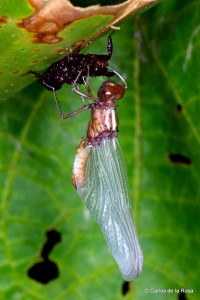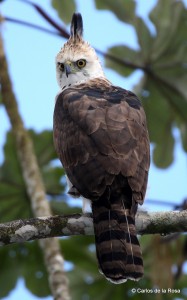 Some days are a bit more exciting than others. Take today, for example. It’s a regular morning, with the howler monkeys calling on the forest behind the house, their calls reverberating through the trees, echoed by the calls of a separate troop a few hundred meters away. We woke up to the usual mix of bird songs, oropendolas gurgling softy over their recently completed long-hanging basket nests; a band of parakeets chatter while feeding on the top of a tree; three or four large parrots, quietly forage. Crested guans softly calli each other from the trees. Other small birds sing, chitter, warble. It’s 6 a.m. and all’s well…
Some days are a bit more exciting than others. Take today, for example. It’s a regular morning, with the howler monkeys calling on the forest behind the house, their calls reverberating through the trees, echoed by the calls of a separate troop a few hundred meters away. We woke up to the usual mix of bird songs, oropendolas gurgling softy over their recently completed long-hanging basket nests; a band of parakeets chatter while feeding on the top of a tree; three or four large parrots, quietly forage. Crested guans softly calli each other from the trees. Other small birds sing, chitter, warble. It’s 6 a.m. and all’s well…
Suddenly, all hell breaks loose. The guans begin to scream, not call, scream, a continuous and deafening whaa-whaa-whaa! Five or six or more of them at the same time. The parrots and parakeets start to scream too, joined by every motmot, oropendola, and every single other bird in the vicinity, all screaming at the top of their lungs. A band of peccaries comes running through the compound towards the forest. The howler monkeys, close and far, also screech. It is really a five-alarm fire, an all-hands-on-deck call, all the ala rms at full blast. What the heck?
rms at full blast. What the heck?
We’re already outside the house, going to breakfast. With our binoculars we scan the trees. Something is up and we don’t know what it is. Suddenly it becomes clear. A very large immature Ornate hawk-eagle (Spizaetus ornatus) is sitting on a branch near the house clearing, watching and listening. Its body is creamy white, fine black barring on its chest, thick black bars across the underside of its slate-gray tail, two black “teardrop” markings drooping from its eyes, and the all characteristic and diagnostic crest over its head. The cinnamon colors of the adult are barely starting to show, but it is clear it is an immature, huge, even gigantic when compared to other local raptors. Its prey consists normally of other birds and mammals, like monkeys or pacas. It can take prey a couple of times its size. No wonder the entire forest went berserk! Claudia scrambles to the house for the field guide while I watch, deafened by the stridency of the moment. The eagle finally has enough, spreads its wings, and flies off, stealth be damned. The entire county knows she’s here.
As soon as if flies silently away, it is like someone pulls the sound plug. Silence. Everyone is quiet, watching, waiting. Is it gone? Is it safe again? Can we resume our normal lives? My questions go in the direction of How can a hawk or an eagle make a living with all these neighborhood watchdogs? How can it catch anything when at first sight EVERYONE starts screaming BLOODY MURDER IN THE WING! It is tough to be a predator. It is fascinating to see a disparate assemblage of animals focus as a single mind to warn off a predator.
We go on towards breakfast, distracted, still looking at the field guide for a positive I.D. I look at the bromeliad-covered stump next to the trail, the one I look at every single day, with its hummingbird flowers, its poison-dart frogs, playing hide-and-seek-the-little-jewel games amidst the mosses, ferns and dead leaves. I look up at the larger bromeliad and see two fresh exuviae (larval skins) of a little puzzling dragonfly that appears to live within the tiny ponds of water held on the axils of the plant. One of them is very dark…too dark…Oh my! It is the whole larvae that has walked out of the water and is perched on the leaf ready to emerge! Now I will be able to photograph the event, collect the larval skin and the adult and get a positive identification of this rare species. We go to breakfast, I eat quickly, get a plastic bag for my collection, and rush back to the bromeliad. The larvae is already coming out! Argh! I’m not ready! Hold it! I snap a couple of shots with my little Pentax and run to the house to get my good camera. Then I park in front of the emerging miracle, snapping pictures, looking around for someone with whom to share this special moment. Eventually people come by, on a bicycle…screech! “Wanna see something cool?” Cameras come out, everyone is watching the miracle of birth (well, not technically correct, more like ecdysis and emergence, but close enough for romantics). It starts to rain. Claudia gets an umbrella while I stand dripping getting wet, camera and all. I decide to cut the section of leaf and take the emerging adult to the office to complete the process. As I am cutting, the little delicate thing falls down and its teneral, delicate wings get crushed, together with my heart. Ugh! Still it is alive, it will complete its hardening and will become a positive record and beautiful pictures of this species on the bromeliads. I see that its lymph, the insect blood that is pumped to the wings to expand them is jewel green, something I would have never seen if it wasn’t for the accident. Hours later, the adult is full dry, wings defective, but it is walking around my desk. I won’t be able to release it (it can’t fly) but it will serve a role in science.
Lunch time comes along. We walk to the dining hall, commenting on things, species we have seen, the strange, sort-of-disturbing smell of some green orchids by the bridge that only smell at night (Epidendrum hunterianum, or Hunters’s Epidendrum, how original…). Enrique Castro, our Biodiversity Programs Manager, is also an expert on orchids and he rattles off the name. however, he was not aware of the smell it disperses only nat night. What is it trying to attract? Something to find out, of course. Inquiring minds want to know! After lunch I go back to the office just in time to hear a call on the radio. “Please let don Carlos know that there’s a tropical chameleon on the bridge.” A what? A chameleon? We don’t have chameleons in La Selva! I grab the radio. “Copied. On my way.” Somehow saying that on the radio makes me feel sillingly important.
I arrive to a crowd on the bridge, tourists snapping pictures, three or four of my staff hanging out pointing, Claudia, a couple of students. I feel like yelling “OK everyone. Clear the bridge! Let me take a look.” I actually say that in jest to a researcher coming my way, making her guffaw. I look over the cables, and there it is. A juvenile bush anole or forest iguana, Polychrus gutturosus, looking a lot like a common green iguana baby, but with an exaggeratedly long brown tail. It starts to walk hesitantly on the branches, very much like a little chameleon, to which I now see the resemblance. It goes up and down branches, peeking through the foliage to disappear again, giving me a single opportunity for a so-so photo. Orlando Vargas, one of the most knowledgeable field biologists I know, and in charge of our scientific operations, explains how rare this is. In thirty years on the region, he has only seen this species three times. They tend to live high up in the canopy, coming close to the ground to mate (he saw that once) and disappear again up the trees, where few humans dare tread.
I now sit in my office, looking at my photos, fascinated by the little jewels of biological information gleaned today. There were more, of course, but these few will make for a memorable day.
Carlos de la Rosa

Recent Comments